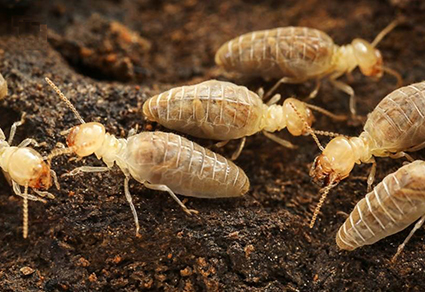Abstract
Ebogotermes raphaeli gen. n. sp. n., is described from workers collected in Cameroon. This soil-feeding termite is the largest soldierless termite from central Africa and aligns with the Anoplotermes subgroup. The enteric valve armature is weakly armed and, as with most apicotermitine species, is uniquely diagnostic.
References
Bourguignon, T., Lo, N., Šobotník, J., Ho, S.Y.W., Iqbal, N., Coissac, E., Lee, M., Jendryka, M., Sillam-Dussès, D., Křížková, B., Roisin, Y. & Evans, T.A. (2017) Mitochondrial phylogenomics resolves the global spread of higher termites, ecosystem engineers of the tropics. Molecular Biology and Evolution, 34, 589–597. https://doi.org/10.1093/molbev/msw253
Coaton, W.G.H. (1971) Five new termite genera from South West Africa (Isoptera: Termitidae). Cimbebasia, Series A, 2 (1), 1–34.
Engel, M.S., Grimaldi, D.A. & Krishna, K. (2009) Termites (Isoptera): Their phylogeny, classification, and rise to ecological dominance. American Museum Novitates, 3650, 1–27. https://doi.org/10.1206/651.1
Hellemans, S., Deligne, J., Roisin, Y. & Josens, G. (2021) Phylogeny and revision of the ‘Cubitermes complex’ termites (Termitidae: Cubitermitinae). Systematic Entomology, 46: 224–238. https://doi.org/10.1111/syen.12458
Krishna, K., Grimaldi, D.A., Krishna, V. & Engel, M.S. (2013) Treatise on the Isoptera of the World. Vols. 1–7. Bulletin of the American Museum of Natural History, 377, 1–2704. https://doi.org/10.1206/377.1
Noirot, C. (2001) The gut of termites (Isoptera). Comparative anatomy, systematics, phylogeny. I. Higher termites (Termitidae). Annales de la Société Entomologique de France, Nouvelle Série, 37, 431–471.
Romero Arias, J., Chevalier, C. & Roisin, Y. (2020) Anatomical specializations of the gizzard in soil-feeding termites (Termitidae, Apicotermitinae): Taxonomical and functional implications. Arthropod Structure & Development, 57, 100942. https://doi.org/10.1016/j.asd.2020.100942
Romero Arias, J., Boom, A., Wang, M., Clitheroe, C., Šobotník, J., Stiblik, P., Bourguignon, T. & Roisin, Y. (2021) Molecular phylogeny and historical biogeography of Apicotermitinae (Blattodea: Termitidae). Systematic Entomology, 46, 741–756. https://doi.org/10.1111/syen.12486
Sands, W.A. (1972) The soldierless termites of Africa (Isoptera: Termitidae). Bulletin of the British Museum (Natural History), Entomology, Supplement 18, 1–244. https://doi.org/10.5962/p.192782
Sands, W.A. (1998) The identification of worker castes of termite genera from soils of Africa and the Middle East. CAB International, Wallingford, 500 pp.
Scheffrahn, R.H., Bourguignon, T., Akama, P.D., Sillam-Dussès, D. & Šobotník, J. (2018) Roisinitermes ebogoensis gen. & sp. n., an outstanding drywood termite with snapping soldiers from Cameroon (Isoptera, Kalotermitidae). ZooKeys, 787, 91–105. https://doi.org/10.3897/zookeys.787.28195
Scheffrahn, R.H. (2019) UF termite database. University of Florida termite collection. https://www.termitediversity.org/ (accessed 29 July 2021)
Scheffrahn, R.H. (2020) Gastrotermes spinatus gen. n. sp. n., an African soil-feeding termite described from the worker caste (Isoptera, Termitidae, Apicotermitidae). Zootaxa, 4789, 291–296. https://doi.org/10.11646/zootaxa.4789.1.12


